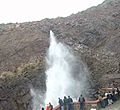Blowhole (geology) facts for kids
A blowhole is a cool natural feature found along coastlines. It's like a giant water spout! Imagine a sea cave that grows deeper into the land and then shoots upwards. When big waves crash into the coast, water rushes into this cave. The water gets squeezed and then bursts out of a hole at the top, creating a huge spray, sometimes with a loud whoosh! The shape of the cave, how high the tide is, and how big the waves are all affect how high the spray goes.
Contents
How Blowholes Work
Blowholes usually form where there are cracks or tunnels in the rock along the coast, like in lava tubes. These areas are often found near fault lines or on islands. When strong waves hit the shore, water rushes into these cracks. Because the water is trapped, it builds up a lot of pressure. This pressure then forces the water and air to shoot out of the hole at the top, often making a loud noise and a wide spray. This is why blowholes are popular places for tourists to visit!
Blowholes are created by the ocean wearing away rocky coastlines. They are found all over the world. They often appear where different rock cracks meet, especially on the windward side of a coastline. This is the side that gets hit by the strongest waves from the open ocean.
A blowhole system has three main parts:
- A catchment entrance: This is where the waves first enter the cave.
- A compression cavern: This is the main part of the cave where the water gets squeezed.
- An expelling port: This is the hole at the top where the water shoots out.
The way these parts are shaped, their angle, and their size all decide how much force the water and air have when they burst out. The blowhole opening is usually at the very end of a littoral cave (a cave formed by the sea). As their name suggests, blowholes can move air very quickly. Strong winds can blow out of them at speeds over 70 kilometers per hour (about 43 miles per hour) when the pressure changes inside the connecting cave.
The process of a blowhole forming starts with the creation of a sea cave. The main things that help form these caves are the power of the waves and the type of rock (called the parent material). Some rocks wear away easily, while others are very strong. Caves made of limestone are formed by a process called karst (which means the rock dissolves). Caves made of other rocks, like volcanic rock, are formed by non-dissolving processes. Over time, the sea cave gets bigger, growing inland and upwards through weak spots in the rock. As the rock continues to wear away, the roof of the cave gets thinner and eventually collapses. This creates a steep-sided inlet, allowing the coastline to change even more.
What Blowholes Do to the Environment
Blowholes can change the shape of the land around them. Over time, they can erode the area around the cracks, making the sea caves even larger. Sometimes, the roof of the cave might even collapse completely. When this happens, it can create shallow pools of water along the coast.
Other Types of Blowholes
The word blowhole can also describe a rare natural feature where air blows out of a small hole in the ground. This happens because of differences in pressure between a hidden underground system and the air above ground.
A famous example of this is at Wupatki National Monument in the United States. Scientists believe the underground passages there are huge, holding at least seven billion cubic feet of air! The wind coming out of these blowholes can reach speeds of nearly 30 miles per hour. Another well-known example is the natural entrance to the Wind Cave.
La Bufadora is a very large blowhole located on the Punta Banda Peninsula in Baja California, Mexico. It's a sea cave with a narrow opening. Every 13 to 17 seconds, it erupts, shooting water up to 100 feet (about 30 meters) into the air!
Images for kids
-
Alofaaga Blowholes on Savai'i Island in Samoa
-
Blowholes on the north coast of Barbados
-
Hummanaya - A blowhole located in Southern Province, Sri Lanka
-
Hālona Blowhole, Oahu, Hawaii
-
Kiama Blowhole, New South Wales, Australia
See also
 In Spanish: Bufadero para niños
In Spanish: Bufadero para niños









